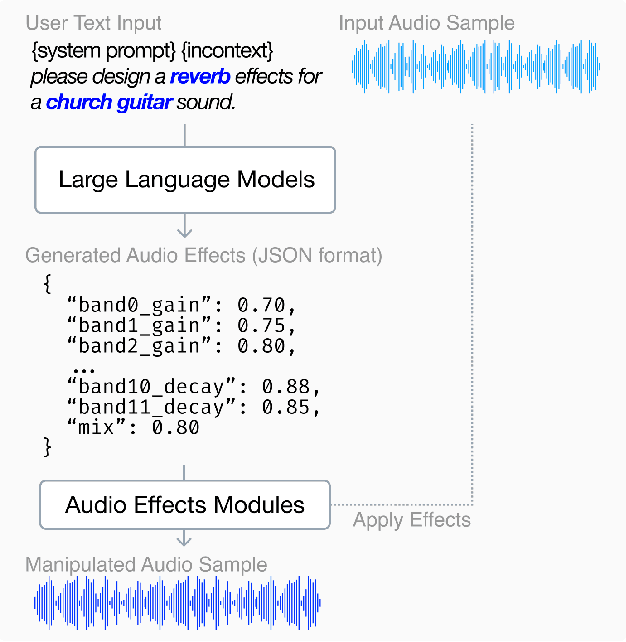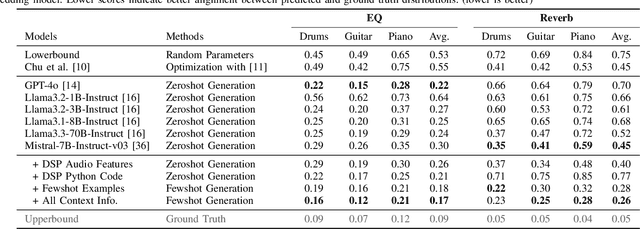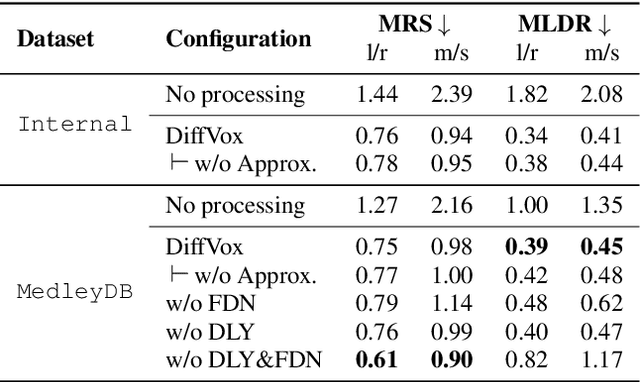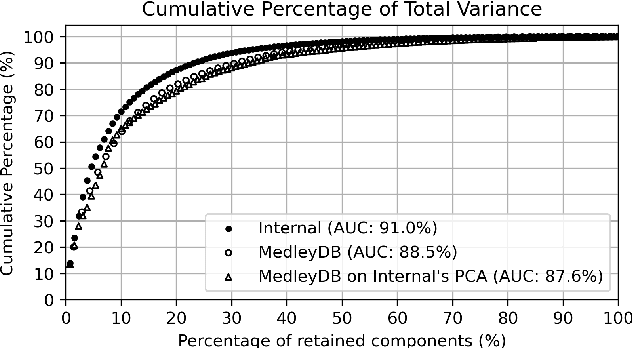Junghyun Koo
Concept-TRAK: Understanding how diffusion models learn concepts through concept-level attribution
Jul 09, 2025



Abstract:While diffusion models excel at image generation, their growing adoption raises critical concerns around copyright issues and model transparency. Existing attribution methods identify training examples influencing an entire image, but fall short in isolating contributions to specific elements, such as styles or objects, that matter most to stakeholders. To bridge this gap, we introduce \emph{concept-level attribution} via a novel method called \emph{Concept-TRAK}. Concept-TRAK extends influence functions with two key innovations: (1) a reformulated diffusion training loss based on diffusion posterior sampling, enabling robust, sample-specific attribution; and (2) a concept-aware reward function that emphasizes semantic relevance. We evaluate Concept-TRAK on the AbC benchmark, showing substantial improvements over prior methods. Through diverse case studies--ranging from identifying IP-protected and unsafe content to analyzing prompt engineering and compositional learning--we demonstrate how concept-level attribution yields actionable insights for responsible generative AI development and governance.
Fx-Encoder++: Extracting Instrument-Wise Audio Effects Representations from Mixtures
Jul 03, 2025Abstract:General-purpose audio representations have proven effective across diverse music information retrieval applications, yet their utility in intelligent music production remains limited by insufficient understanding of audio effects (Fx). Although previous approaches have emphasized audio effects analysis at the mixture level, this focus falls short for tasks demanding instrument-wise audio effects understanding, such as automatic mixing. In this work, we present Fx-Encoder++, a novel model designed to extract instrument-wise audio effects representations from music mixtures. Our approach leverages a contrastive learning framework and introduces an "extractor" mechanism that, when provided with instrument queries (audio or text), transforms mixture-level audio effects embeddings into instrument-wise audio effects embeddings. We evaluated our model across retrieval and audio effects parameter matching tasks, testing its performance across a diverse range of instruments. The results demonstrate that Fx-Encoder++ outperforms previous approaches at mixture level and show a novel ability to extract effects representation instrument-wise, addressing a critical capability gap in intelligent music production systems.
Can Large Language Models Predict Audio Effects Parameters from Natural Language?
May 27, 2025



Abstract:In music production, manipulating audio effects (Fx) parameters through natural language has the potential to reduce technical barriers for non-experts. We present LLM2Fx, a framework leveraging Large Language Models (LLMs) to predict Fx parameters directly from textual descriptions without requiring task-specific training or fine-tuning. Our approach address the text-to-effect parameter prediction (Text2Fx) task by mapping natural language descriptions to the corresponding Fx parameters for equalization and reverberation. We demonstrate that LLMs can generate Fx parameters in a zero-shot manner that elucidates the relationship between timbre semantics and audio effects in music production. To enhance performance, we introduce three types of in-context examples: audio Digital Signal Processing (DSP) features, DSP function code, and few-shot examples. Our results demonstrate that LLM-based Fx parameter generation outperforms previous optimization approaches, offering competitive performance in translating natural language descriptions to appropriate Fx settings. Furthermore, LLMs can serve as text-driven interfaces for audio production, paving the way for more intuitive and accessible music production tools.
Improving Inference-Time Optimisation for Vocal Effects Style Transfer with a Gaussian Prior
May 16, 2025Abstract:Style Transfer with Inference-Time Optimisation (ST-ITO) is a recent approach for transferring the applied effects of a reference audio to a raw audio track. It optimises the effect parameters to minimise the distance between the style embeddings of the processed audio and the reference. However, this method treats all possible configurations equally and relies solely on the embedding space, which can lead to unrealistic or biased results. We address this pitfall by introducing a Gaussian prior derived from a vocal preset dataset, DiffVox, over the parameter space. The resulting optimisation is equivalent to maximum-a-posteriori estimation. Evaluations on vocal effects transfer on the MedleyDB dataset show significant improvements across metrics compared to baselines, including a blind audio effects estimator, nearest-neighbour approaches, and uncalibrated ST-ITO. The proposed calibration reduces parameter mean squared error by up to 33% and matches the reference style better. Subjective evaluations with 16 participants confirm our method's superiority, especially in limited data regimes. This work demonstrates how incorporating prior knowledge in inference time enhances audio effects transfer, paving the way for more effective and realistic audio processing systems.
DiffVox: A Differentiable Model for Capturing and Analysing Professional Effects Distributions
Apr 20, 2025



Abstract:This study introduces a novel and interpretable model, DiffVox, for matching vocal effects in music production. DiffVox, short for ``Differentiable Vocal Fx", integrates parametric equalisation, dynamic range control, delay, and reverb with efficient differentiable implementations to enable gradient-based optimisation for parameter estimation. Vocal presets are retrieved from two datasets, comprising 70 tracks from MedleyDB and 365 tracks from a private collection. Analysis of parameter correlations highlights strong relationships between effects and parameters, such as the high-pass and low-shelf filters often behaving together to shape the low end, and the delay time correlates with the intensity of the delayed signals. Principal component analysis reveals connections to McAdams' timbre dimensions, where the most crucial component modulates the perceived spaciousness while the secondary components influence spectral brightness. Statistical testing confirms the non-Gaussian nature of the parameter distribution, highlighting the complexity of the vocal effects space. These initial findings on the parameter distributions set the foundation for future research in vocal effects modelling and automatic mixing. Our source code and datasets are accessible at https://github.com/SonyResearch/diffvox.
TokenSynth: A Token-based Neural Synthesizer for Instrument Cloning and Text-to-Instrument
Feb 13, 2025Abstract:Recent advancements in neural audio codecs have enabled the use of tokenized audio representations in various audio generation tasks, such as text-to-speech, text-to-audio, and text-to-music generation. Leveraging this approach, we propose TokenSynth, a novel neural synthesizer that utilizes a decoder-only transformer to generate desired audio tokens from MIDI tokens and CLAP (Contrastive Language-Audio Pretraining) embedding, which has timbre-related information. Our model is capable of performing instrument cloning, text-to-instrument synthesis, and text-guided timbre manipulation without any fine-tuning. This flexibility enables diverse sound design and intuitive timbre control. We evaluated the quality of the synthesized audio, the timbral similarity between synthesized and target audio/text, and synthesis accuracy (i.e., how accurately it follows the input MIDI) using objective measures. TokenSynth demonstrates the potential of leveraging advanced neural audio codecs and transformers to create powerful and versatile neural synthesizers. The source code, model weights, and audio demos are available at: https://github.com/KyungsuKim42/tokensynth
VRVQ: Variable Bitrate Residual Vector Quantization for Audio Compression
Oct 12, 2024Abstract:Recent state-of-the-art neural audio compression models have progressively adopted residual vector quantization (RVQ). Despite this success, these models employ a fixed number of codebooks per frame, which can be suboptimal in terms of rate-distortion tradeoff, particularly in scenarios with simple input audio, such as silence. To address this limitation, we propose variable bitrate RVQ (VRVQ) for audio codecs, which allows for more efficient coding by adapting the number of codebooks used per frame. Furthermore, we propose a gradient estimation method for the non-differentiable masking operation that transforms from the importance map to the binary importance mask, improving model training via a straight-through estimator. We demonstrate that the proposed training framework achieves superior results compared to the baseline method and shows further improvement when applied to the current state-of-the-art codec.
Variable Bitrate Residual Vector Quantization for Audio Coding
Oct 08, 2024Abstract:Recent state-of-the-art neural audio compression models have progressively adopted residual vector quantization (RVQ). Despite this success, these models employ a fixed number of codebooks per frame, which can be suboptimal in terms of rate-distortion tradeoff, particularly in scenarios with simple input audio, such as silence. To address this limitation, we propose variable bitrate RVQ (VRVQ) for audio codecs, which allows for more efficient coding by adapting the number of codebooks used per frame. Furthermore, we propose a gradient estimation method for the non-differentiable masking operation that transforms from the importance map to the binary importance mask, improving model training via a straight-through estimator. We demonstrate that the proposed training framework achieves superior results compared to the baseline method and shows further improvement when applied to the current state-of-the-art codec.
Latent Diffusion Bridges for Unsupervised Musical Audio Timbre Transfer
Sep 09, 2024Abstract:Music timbre transfer is a challenging task that involves modifying the timbral characteristics of an audio signal while preserving its melodic structure. In this paper, we propose a novel method based on dual diffusion bridges, trained using the CocoChorales Dataset, which consists of unpaired monophonic single-instrument audio data. Each diffusion model is trained on a specific instrument with a Gaussian prior. During inference, a model is designated as the source model to map the input audio to its corresponding Gaussian prior, and another model is designated as the target model to reconstruct the target audio from this Gaussian prior, thereby facilitating timbre transfer. We compare our approach against existing unsupervised timbre transfer models such as VAEGAN and Gaussian Flow Bridges (GFB). Experimental results demonstrate that our method achieves both better Fr\'echet Audio Distance (FAD) and melody preservation, as reflected by lower pitch distances (DPD) compared to VAEGAN and GFB. Additionally, we discover that the noise level from the Gaussian prior, $\sigma$, can be adjusted to control the degree of melody preservation and amount of timbre transferred.
SMITIN: Self-Monitored Inference-Time INtervention for Generative Music Transformers
Apr 02, 2024



Abstract:We introduce Self-Monitored Inference-Time INtervention (SMITIN), an approach for controlling an autoregressive generative music transformer using classifier probes. These simple logistic regression probes are trained on the output of each attention head in the transformer using a small dataset of audio examples both exhibiting and missing a specific musical trait (e.g., the presence/absence of drums, or real/synthetic music). We then steer the attention heads in the probe direction, ensuring the generative model output captures the desired musical trait. Additionally, we monitor the probe output to avoid adding an excessive amount of intervention into the autoregressive generation, which could lead to temporally incoherent music. We validate our results objectively and subjectively for both audio continuation and text-to-music applications, demonstrating the ability to add controls to large generative models for which retraining or even fine-tuning is impractical for most musicians. Audio samples of the proposed intervention approach are available on our demo page http://tinyurl.com/smitin .
 Add to Chrome
Add to Chrome Add to Firefox
Add to Firefox Add to Edge
Add to Edge